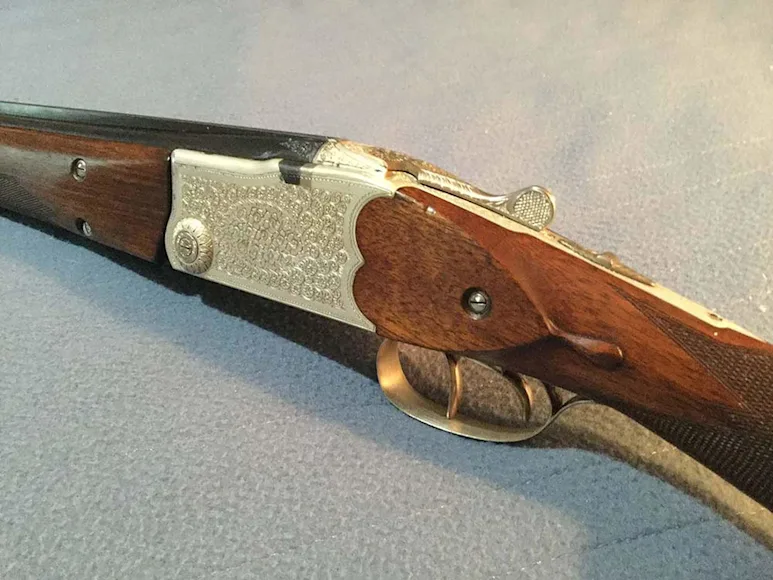We may earn revenue from the products available on this page and participate in affiliate programs. Learn more ›
For more than two years on The Gun Nuts, readers have been sending us submissions for our series of vintage firearms, Blast From the Past. If you were to gather all of the firearms together into one massive gun safe, you would arguably have the greatest, most enviable collection of guns in the world, including classic rifles, fine shotguns, and even a couple truly rare guns (the Fly Gun?). Without question, though, the best and most priceless guns in this collection are the heirloom rifles and shotguns that have been in families for generations—passed down from fathers to sons to grandsons—and are still used in the woods during hunting season every fall. What follows is a list of some of our favorite Blasts From the Past.
Vintage Single-Shot Shotguns
1. Stevens Model 94
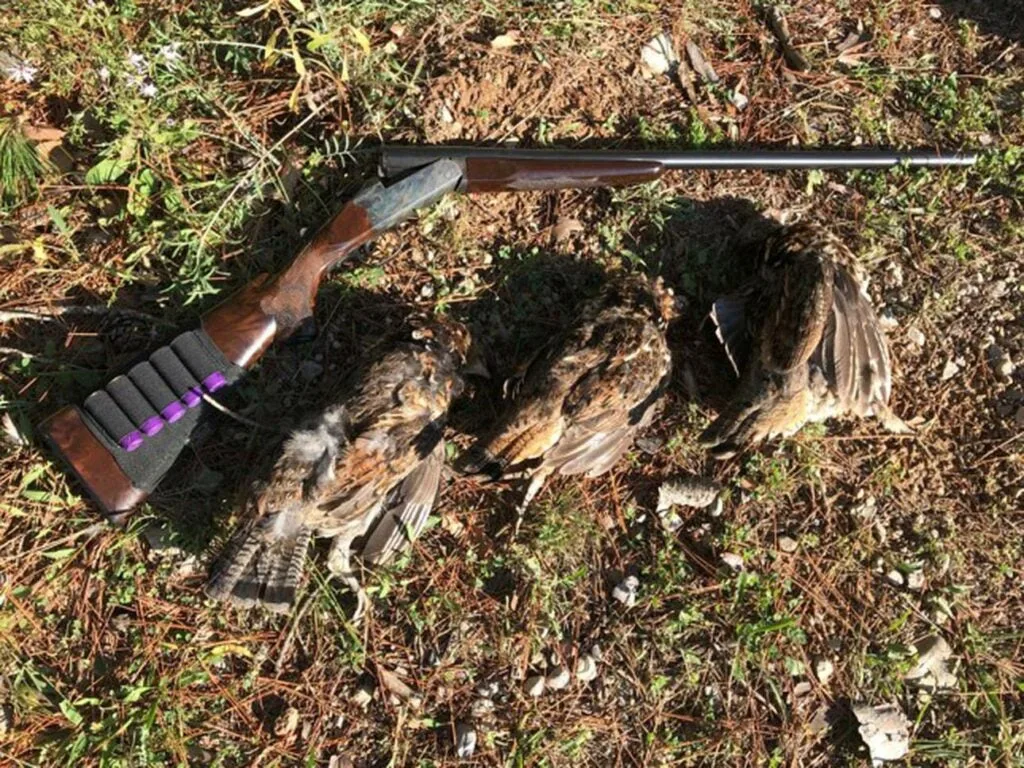
This vintage Stevens single shot still does a number on the grouse each fall. Reader Photo
In 1963, when I was 15 years old and growing up in Lansing, Mich., my Uncle Jerry had me do a few odd jobs for him, and as payment he presented me with a Stevens Model 94 16-gauge—an old single shot shotgun with a Tenite synthetic stock. It was my only shotgun for many years, but eventually I sold it as I began a career as a Michigan conservation officer and moved to northern Michigan.
I always felt bad about selling that gun, especially after Uncle Jerry passed away. While spending time with family in Lansing during Christmas in 2015, I stopped at Classic Arms. As I was browsing the used gun rack, my eyes came to rest on that old shotgun, looking forlorn and unwanted. I knew it was the same gun because I remembered some of the marks on the stock.
Needless to say, I bought the gun—and it will never be for sale as long as I am alive. I had a gunsmith replace some springs and open the choke. I take the old gal grouse hunting each fall and always seem to have good luck when I am carrying it. It feels like Uncle Jerry is tagging along, and brings back many memories of a better world that I lived in so long ago. Maybe he was tugging at my shirtsleeves and leading me into the store that day, to give me that gun for the second time now that I am old enough to appreciate it. —Bob
2. Model 48 Topper
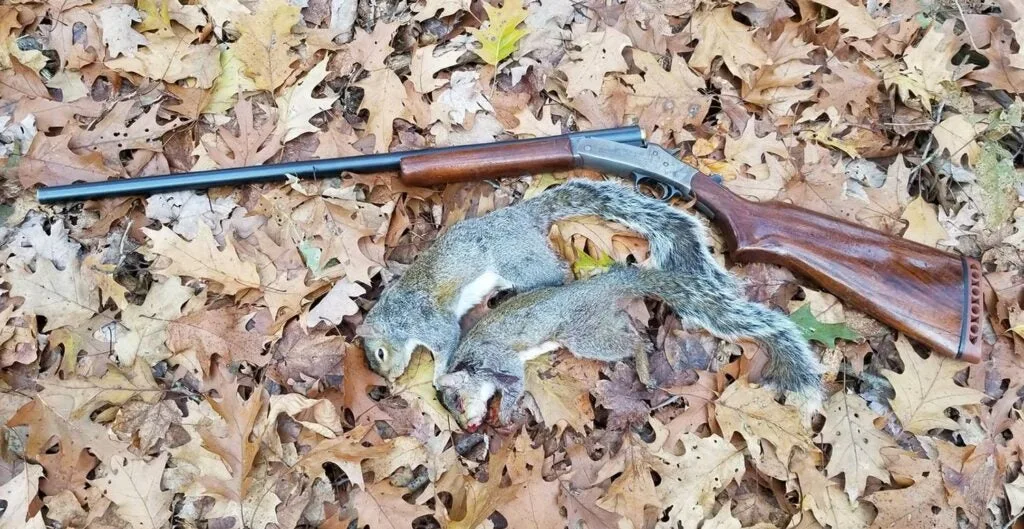
Patrick’s single-shot 16-gauge. Reader Photo
It’s far from being a very old or rare gun, but this Model 48 Topper means a lot to me. Going into the outdoors with my grandpa made for some of my fondest childhood memories. Now, a few years after his passing, I’m not able to go with him, but taking his gun still brings him with me, and the 1940s-era 16-gauge reminds me of those life lessons and memories.
Growing up at a time when the 16-gauge was considered obsolete added to the gun’s mystique for me. I can remember being a wide-eyed child, looking at the dark-stained stock and having my grandfather tell me: “I was 16 and wanted a gun to hunt rabbits, so I got a 16-gauge.” The broken bead and every scar on the stock all add to its story. Carrying this old single shot shotgun on a simple Thanksgiving-morning squirrel hunt makes it one of my favorite days of the year. —Patrick
Classic Double-Barrel Shotguns
3. MacNaughton Bar-in-Wood

The triggerplate design is what really makes this a unique gun. Reader Photo
The serial number on my uncle’s bar-in-wood MacNaughton is 9xx, which suggests it was made sometime in the late 1800s. The bar-in-wood action is beautiful, and it also has Damascus steel barrels which complete the tasteful look.
What makes this double-barrel shotgun even more special, though, is how it came into my uncle’s possession. He inherited it from my great-uncle who had a home FFL (and also wrote a few stories for Field & Stream back in the day). This shotgun was found in a rotting crate in the back of my great-uncle’s house after he died, and no one knew exactly how he came to be the owner. Anyway, now it is a nice wall hanger, but my uncle and I are considering selling this rare gun to fund a trip to Africa. —Andrew
4. Cogswell and Harrison Konor 12 Gauge
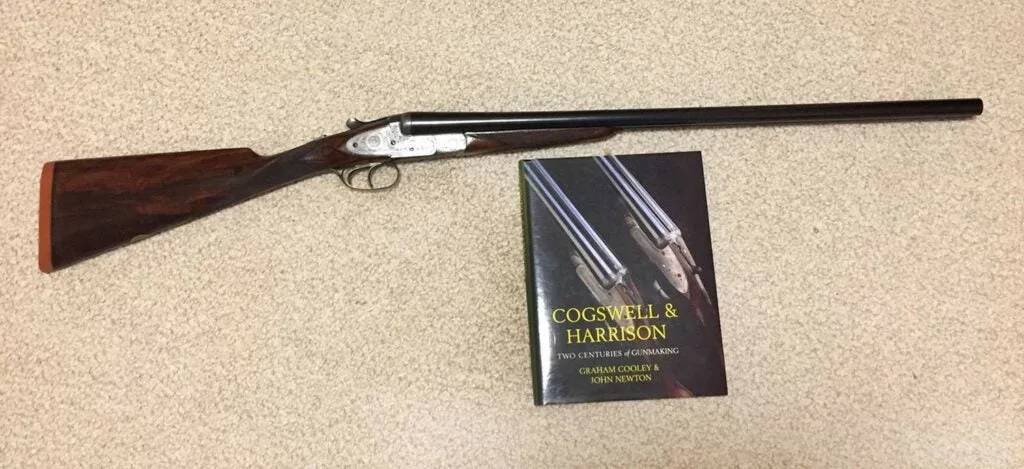
An English Cogswell and Harrison Konor 12 gauge with double triggers and ejectors. Dennis
This is my favorite shotgun for flushing birds, an English Cogswell & Harrison Konor 12 gauge, with double triggers and ejectors. With 26-inch open-choked barrels, it is a 6.5 pound delight. It was special ordered by a Mr. Hobden and crafted to his specifications. He took delivery at the maker’s London showroom on Picadilly Street in December, 1958, according to the factory letter that accompanies the shotgun. The history of the shotgun after it left the showroom is unknown to me until I purchased it in 2012 from a Texas gun dealer. Mr. Hobden must have been about my size and stature since the shotgun fits me perfectly, and at a fraction of the cost of a new custom double. I can hardly wait for the Wisconsin fall bird season to begin once again! The shotgun is featured on page 85 of the book, “Cogswell & Harrison: Two centuries of Gunmaking,” by Cooley and Newton. —Dennis
5. Parker VH
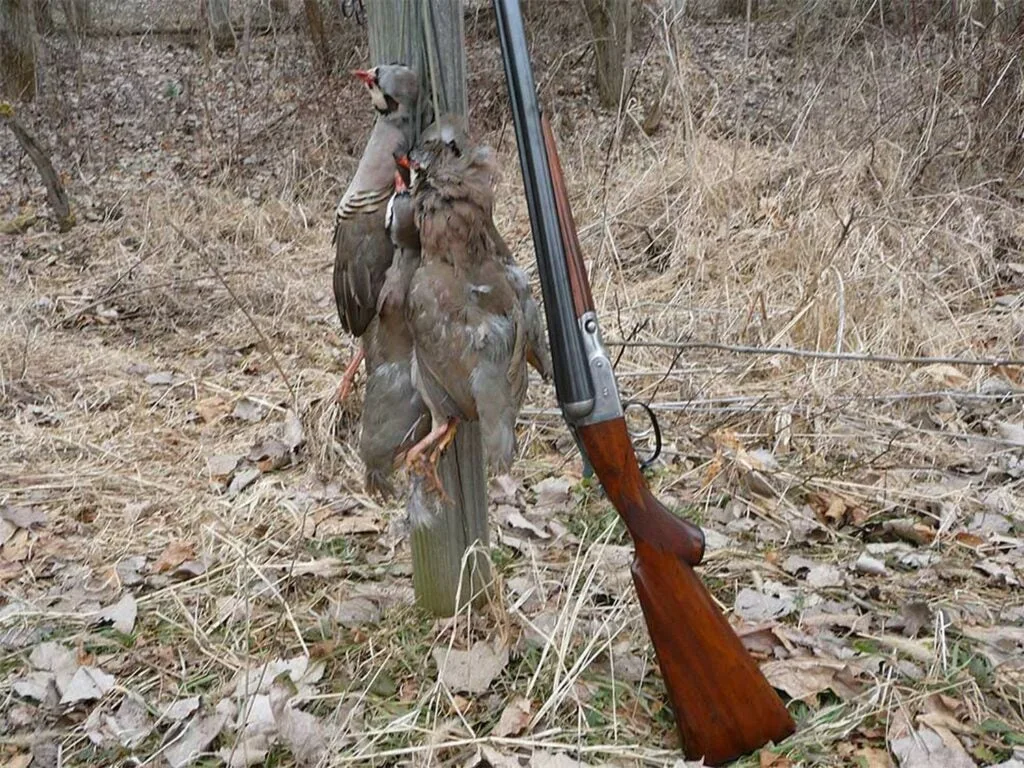
Good as ever, this old Parker didn’t disappoint on a chukar hunt. Reader Photo
Every now and again a piece turns up that tickles your fancy in a way that you can’t explain. Like Charlie Brown and his forlorn-looking Christmas tree, you might even think it needs you as much as you might think you need it. A couple of months ago, I picked up a nice old Parker VH 12-gauge double-barrel shotgun on a 1 ½ frame with 28-inch tubes choked Modified and Full. This one showed lots of honest use with faint case colors remaining in the protected areas only, and the scratches, dings, and rubs usual to field guns—but it was all original and tight as they come. I bought it to shoot, and so I didn’t mind having the stock rubbed-out, checkering re-cut, and the barrels and trigger bow re-blued. It came back looking great, and today I had the pleasure of taking it out on a preserve hunt for chukars. The old girl made a nice showing using RST 2 ½-inch No. 7 ½ loads, as the game strap in the photo will attest.
I know some will cringe at the thought of restoring a rare gun like an original Parker, but I just love to hunt with old classic shotguns and don’t own any safe queens. Bringing this one back to a semblance of its original glory means I’ll use it proudly and often and with no apologies. I have another VH on a 2 frame with 30-inch barrels that I also enjoy shooting, but I think this new one could become a go-to uplander for me. It’s a bit livelier in the hands, swings like a dream, and is a joy to carry. And it looks right at home standing in the front row of the safe along with the others that I tend to reach for first.
I’ve long had a love affair with walnut and blue steel: old double-barrel shotguns, Belgian Brownings, lever-actions, bolt guns—basically anything made before I was born, which was 1963. I own a couple of all-weather guns for practical reasons, but to me they’re just tools. They have no soul. The wife tells me often that I was born in the wrong century. I think she’s right. —Greg
6. L.C. Smith Shotgun
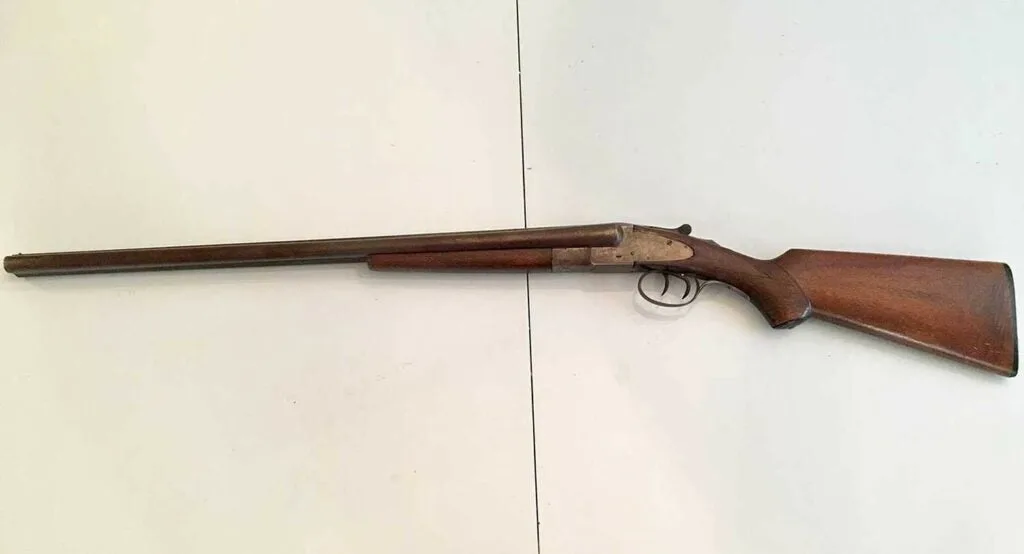
The reader’s L.C. Smith shotgun still gets some use to this day. Reader Photo
The gun is a 16-gauge L.C. Smith made, I believe, in 1913. It smells of oil, and has some small nicks and scratches in the wooden stock. My grandfather, Skeet Miller, bought it used at a hardware store in the’50s or ’60s. He shot ducks, dove, and quail with it for years. I still shoot it today, though only rarely because I’m afraid of what could happen to the thing. He would probably prefer if I shot it more.
The gun reminds me of my grandfather the same way that the smell of black coffee and cigarette smoke remind me of him. I remember those smells, and seeing that gun on early fall mornings before the sun had come up. Dressed in my older brother’s hand-me-down camouflage coveralls with a five-gallon bucket in one hand and a single-shot 20-gauge in the other, I would be tromping through a wet peanut field with my grandfather by my side.
My grandfather would coach me to lead doves a bit, and to wait until they were on top of our position before I shot. I would miss with my single shot, and then he would drop one with that old L.C. Smith. He would then thank me and say he thought I winged one of the birds, slowing it up for him to hit. I didn’t believe him but it gave me something to tell my brother when the hunt was over.
I was 8 years old the first time I didn’t miss. We were sitting on a fence row on my grandmother’s farm. There was an oak tree about 20 yards north of us, and a dove lit on one the branches. Taking careful aim, I fired, and the dove toppled over. I threw my gun down barrel first into the plowed earth, and ran to my bird as excited as if I had killed a charging grizzly. My grandfather cheered and bragged on me for a while, and then told me not to throw guns down into the dirt.
In his late 70s, my grandfather had pretty much given up hunting. One day, he called me over to his house and asked me to hang on to the gun for him. He made sure to tell me he wasn’t giving the gun to me, but that I could use it since he wasn’t. I loved it. I felt like a man because my grandfather sure as hell was a man, and that was his gun. I shot ducks with it in a beaver slough behind my parent’s house; quail in the pine woods outside of town; and clays with my friends. The gun came to my shoulder like it paid rent there, and dropped birds as well as any shotgun I had ever used.
Into his early 80s, my grandfather started having health problems. The last time I saw him he was out of it, but he came around long enough to look me in the eye and tell me to keep that shotgun. He died a week later.
My grandfather taught me a lot of things besides shooting birds. He taught me how to play a hand of poker, how to catch a catfish, how to drive through a muddy field, and lots of other things my mother would not care to know about. Above everything else though, my grandfather taught me what it is to love someone. I know he loved me because he took the time to show me the things that were important to him, and to teach me to do those things properly.
A grandfather’s love is what I think about when I look at that old shotgun. —Jarrett
Read Next: How to Make the Toughest Shots in the Dove Field
7. Weatherby Orion Over/Under 12 Gauge
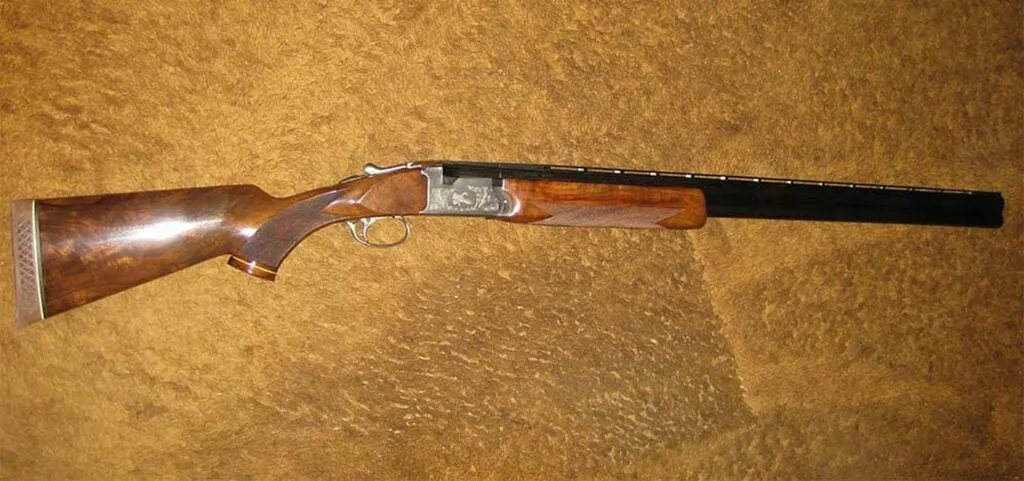
This Weatherby Orion Grade III is, no surprise, one of the reader’s favorite shotguns. Reader Photo
This is my Weatherby Orion Grade III, 12-gauge o/u shotgun. It has 30-inch barrels, a single selective inertia trigger, and auto ejectors. I use it for skeet and some small game. The wood is beautiful, so I try to take care of it and not abuse it. The long barrels give it slight front heavy balance but it seems to suit me well. This was made in Japan by SKB, the maker of other fine firearms. This is one of my favorite guns. —JHjimbo
8. MTs-108
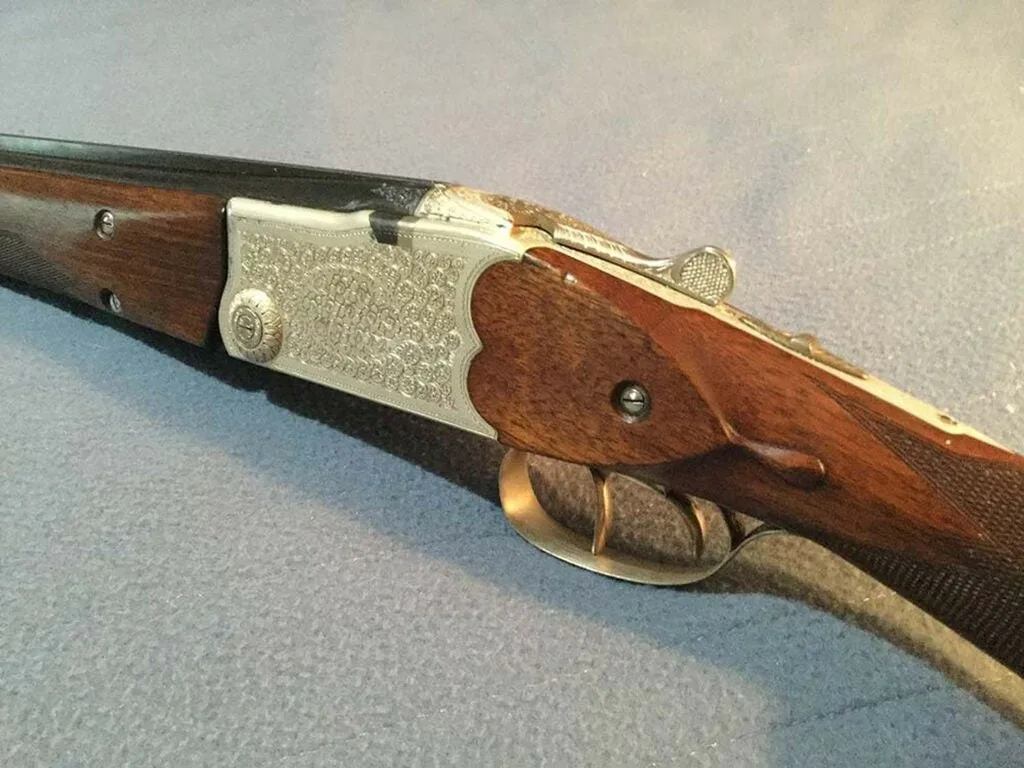
This made-in-Russian shotgun now serves as a quail gun. Reader Photo
Here’s a picture of the MTs-108 that followed me home after I fell in love with her at a gunshow. The moment I picked it up from the other plain-Jane guns on a dealer’s table, I was reminded of the line from Robert Ruark concerning an innocent young bird-dog pup that had just scented his first quail. I’m paraphrasing here: He didn’t know exactly what that magical smell was, but he knew it had something to do with his future.
What’s impossible to capture for a mass audience is the soul of the little thing. We’ve all known Russian weaponry to be clunky, stamped, mass-produced, killing machines. Not this little darling.
Nobody at the show knew what the darn thing was. My exhibitor friend, whose table it was on, kindly let me take it around the show to get opinions from other, more knowledgeable dealers. All scratched their heads in puzzlement. “Probably a European apprentice’s masterwork” was the best guess. A few tiny stampings in Cyrillic were the only clues. The metal-to-metal fit was absolutely breathtaking, on par with a bespoke Brit double.
Yes, the checkering is not state-of the art perfection, but you’d only notice in strong light, with a jeweler’s loupe. But griping about the checkering is like being on a date with Cindy Crawford in a fine restaurant and fixating only on her beauty-mark.
On its first day afield in south Georgia, with sharp golden sunlight streaming through the pines on a cold, crisply-beautiful November morning, with world-class dogs pointing wild quail, that damn gun tumbled every bird I shot at. —Dave
Other Vintage Shotguns
9. Remington Model 58
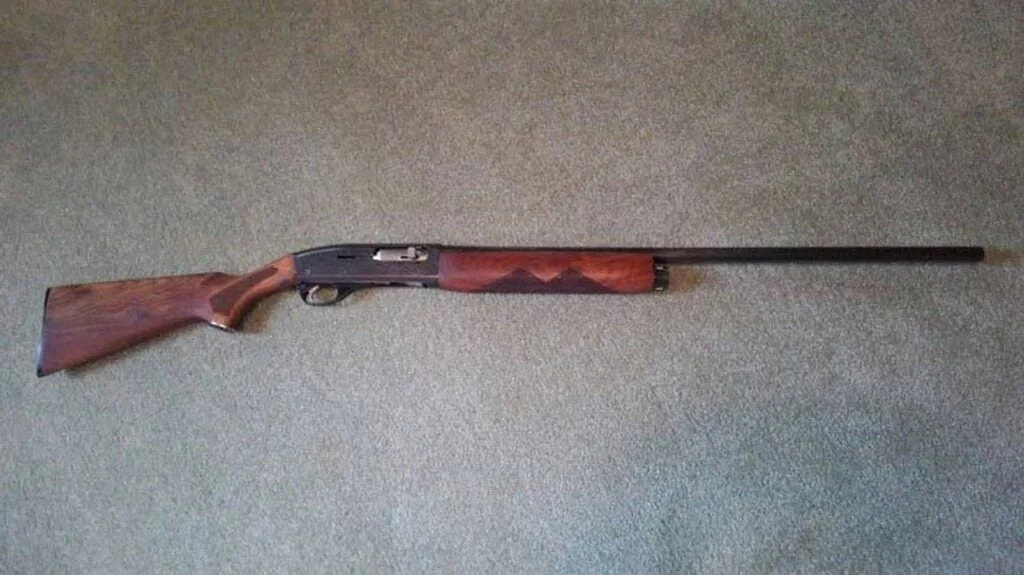
The reader refurbished this Remington at home. After taking it completely apart, he sanded and refinished the stock, removed the rust and cold blued the metal. Reader Photo
This is my father’s Remington Sportsman 58. I recovered the gun from his attic after he passed away in January 2018. The gun had suffered water damage after a tree broke through the roof during a storm years ago. The exterior of the barrel and receiver were badly rusted, and the finish on the wood was ruined. Even though I have never repaired a firearm before, I decided to try refurbishing this gun. I took it completely apart (I left the trigger group intact), carefully removed the rust, stripped and lightly sanded the stock and forearm, cold-blued the steel and treated the wood with Dutch Oil. I also installed a left-hand safety button. I just put it back together, and I am very pleased with how it turned out. The gun has a lot of nice details, with beautiful engraving on the sides of the receiver, lovely wood with checkering, and a small metal plate on the bottom of the stock grip that shows a bird dog with a duck in its mouth. The gun shoots well at the range, and I’m hoping to take some game with it this fall in memory of my father. —Scott
Read Next: How to Know Whether You Should Restore or Refurbish an Old Hunting Gun
10. Remington 11-48
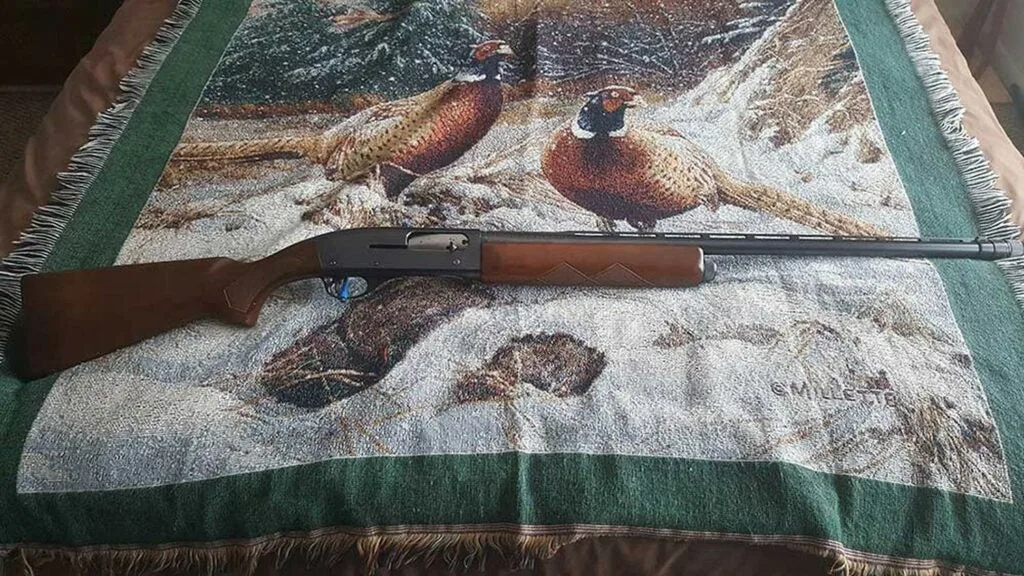
Though discontinued, the Remington 11-48 shared some of the same components as the famous Remington 870 shotgun. Reader Photo
My brother won this Remington 11-48 in a long pheasant tailfeather contest about 60 years ago. A friend of his shot the bird and entered it under my brother’s name and told my brother what he did. In the end, my brother won the gun. He went in to pick it up and gave a made-up story about “a long cornfield shot” and got his picture in the paper.
About two years ago, my brother gave the gun to that friend’s son. Later, I was in a gun shop and saw it in a rack. I recognized it by one particular scar in the stock.
When my wife heard me tell my son about it, she said I should buy it. I went back a few days later to get it, but it was gone. My 73rd birthday rolled around and the family celebrated at the pizza shop with gifts. We were about to leave when my son said “Pops, I went to the gun shop and asked about that old gun but all they had left was the magazine cap. I thought you’d like it as a keepsake.”
Memories came flooding back when he handed it to me. Then he said, “The rest is in my car, I couldn’t bring it in the restaurant.” So, the old gun now sits in my rack—a piece of firearms history, and now our family history. —Loel
11. Browning Auto 5 Sweet 16

This Sweet 16 came with a leather case and two barrels. It cost Jim’s father $164 in 1965. Reader Photo
My dad was an Air Force pilot who flew B17s in WWII and B52s during the Cold War. He bought this Sweet 16 in 1965 at a base exchange. It has a 26-inch IC barrel and a 28-inch Modified barrel in a Browning fitted luggage case, and it cost him $164. He apparently lost interest in shotgunning soon after and put the gun away until he gave it to me in 1993. Several boxes of “all new” plastic shells came with it. I have shot a few hundred rounds on clays and more recently used it on a released pheasant and chukar hunt in Arkansas. Now that I am retired and have time, I intend to get in some dove and quail hunts in Texas with the gun next fall. The Sweet 16 does carry like a 20 and hit like a 12, and I am having no trouble finding affordable 16-gauge field loads at the local Academy or Walmart. —Jim
12. Winchester Model 12 16-Gauge
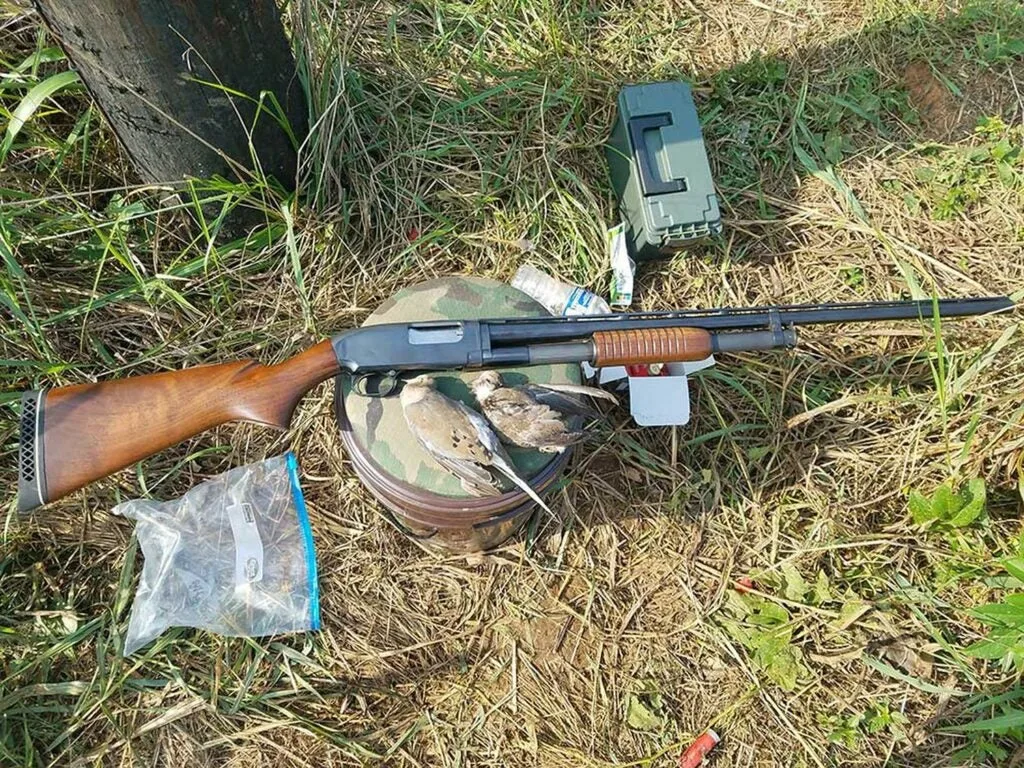
The owner recently had some success in the dove field with his Winchester Model 12. Reader Photo
My family is from the coal-mining country of western Kentucky. My granddad, his father, and almost everyone in family from that generation worked in the mines. This gun was given to my granddad’s cousin during a miner’s strike in the 1950s. After the strike was over, my granddad bought the gun from him. Best I can tell, it started life as a plain-barrel field gun and sometime later it was sent of Simmons for a vent rib.
What a beautiful swinging gun! It balances perfectly at the breakdown point. I took it on dove hunt this weekend. First dove in my sights dropped dead. The 28-inch barrel is just the ticket. Not many birds came in my range, but I managed two. I will never let this gun go. It will be an heirloom in my family. —Jordan
Read Next: The 8 Best Lever-Action Rifles Ever Made
13. Remington 11-87
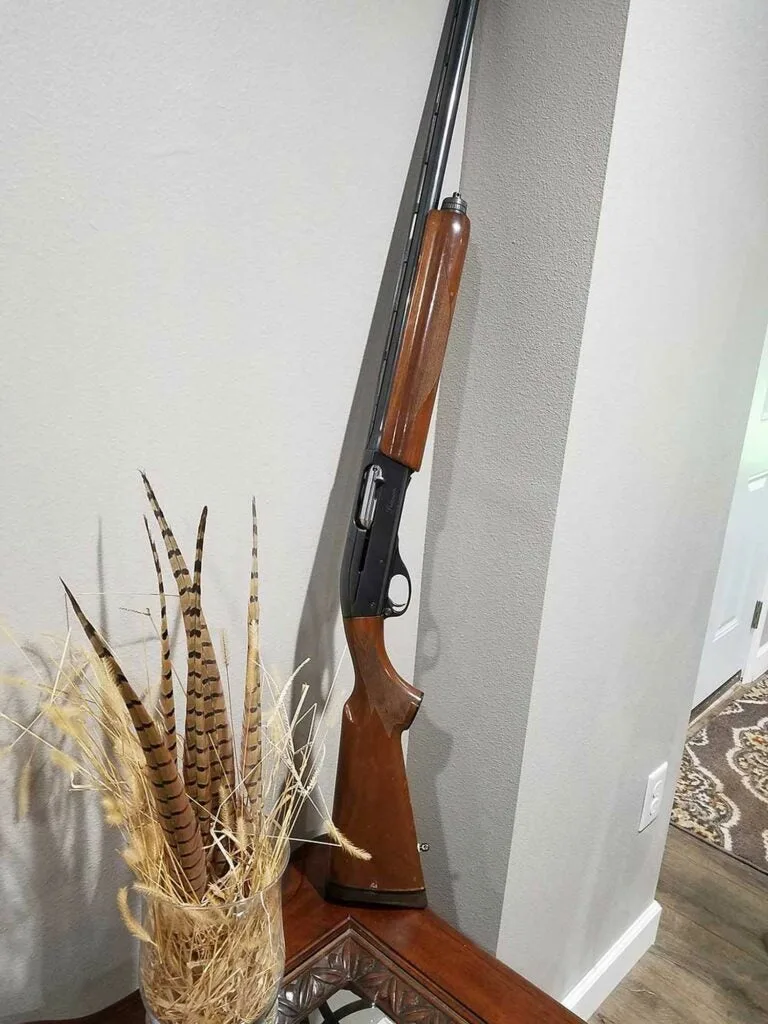
This 11-87 is the shotgun half of a pair of Remingtons—the other half being a Model 700—that the reader inherited from his father. Reader Photo
I recently shared how I came to inherit my dad’s Remington 700 and took it on an elk hunt (didn’t get one, but had a good time hunting with my uncles and Dad’s old rifle). This is another of Dad’s old guns, a Remington 11-87 that he bought about the same time he bought the rifle. Both had blued steel, walnut wood, and silver bolts. I think he had bought them as sort of a matching rifle/shotgun pair. This particular 11-87 was mainly used in South Dakota where we lived for several years. In that time, it accounted for hundreds of pheasants, because, well, if you’re a hunter living in South Dakota you’re basically obligated to hunt pheasants. I have taken it out a couple of times myself and bagged a couple of birds with it, but hopefully next year I will be able to take it back to South Dakota and hunt there. It just so happens I have a cousin who married a farmer who has ground near where we used to live. I think I can easily find a way to invite myself up for opening day next year. —Alex
Classic Old Rifles
14. Winchester Model 88

The moose on the sling on this Winchester Model 88 is a tribute to the owner’s dad, who shot a bull with the rifle in 1997. Reader Photo
This is my old Winchester Model 88 in .308. This rifle was made in 1956. My grandfather had a Model 88 carbine, and I always wanted one. This one belonged to my father. I made a deal with him as a young guy that if I bought a plow for the ATV, he would give me the rifle.
Dad killed his New Hampshire moose back in 1997 with this rifle, and I shot my first deer with it. Hopefully, my 2-year-old son will do the same. I refinished the stock years ago and, being young, I didn’t care to rechecker it, so it remains plain. I found an old 2-7 Redfield to put on it and complete the process of bringing dad’s rifle back to its glory days (I hate new scopes on old rifles). The sling sports a bull moose in memory of Dad’s dream hunt
from long ago. It might not be fancy—the trigger pull is godawful—but it’s my go-to for the final days of deer season. —Wyatt
15. Sako Finnbear L61R
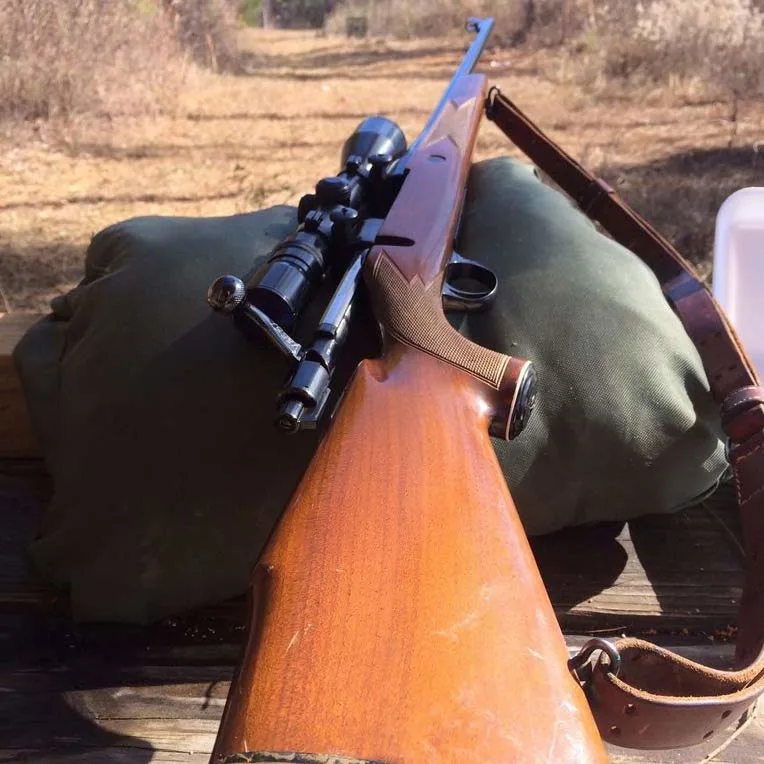
The owner of this Sako Finnbear found very little to change about the inherited rifle. Reader Photo
This is my grandpa’s Sako Finnbear L61R, chambered in .270. Made in Finland, probably around the early 1960s, it has the Bofors Steel stamp on the barrel and a serial number in the 12000s. Topped with an old Kahles 3X9 scope, the rifle still shoots better than I can.
I inherited the rifle in 2014, after my grandpa passed. The gun shows use but was well taken care of. It had not been shot in decades when I got it. But you wouldn’t know that based on my first 5 group. A few clicks of elevation and everything was right where it should be, and right how my grandpa left it.
I’ve thought about putting a new scope on the gun, but I can’t bring myself to break apart the setup my grandpa started putting together more than 50 years ago. Sure, it might cost me a deer in low-light conditions, but having my grandpa with me on every hunt is worth it. —Stephen
16. Remington 7400
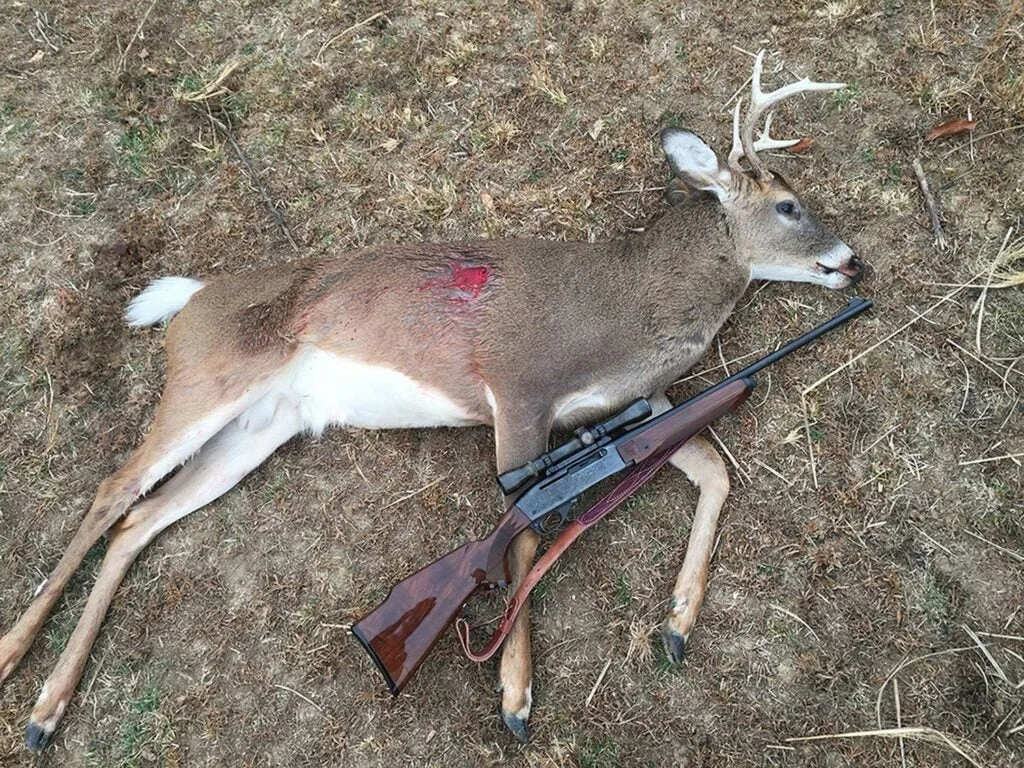
Less than an hour into the deer season, Jake killed this buck with his Remington 7400. Jake
My dad gave me this .30/06 Remington 7400 a couple of years ago when he bought a new deer rifle. It has factory engraving and upgraded wood. This year, I topped it with an old El Paso Weaver K4 in super-low Leupold mounts. The super-low scope rings allow me to get a solid cheek weld. The old Weaver fogs occasionally, and it has a couple of chips in the rear lens, but I like the look of the old blued-steel scope—so I put up with it. This buck was in hot pursuit of a yearling doe. I heard him grunting right before he cruised around the side of a knob I was watching. I was only 45 minutes into my deer season when I pulled the trigger. —Jake
17. Remington 700
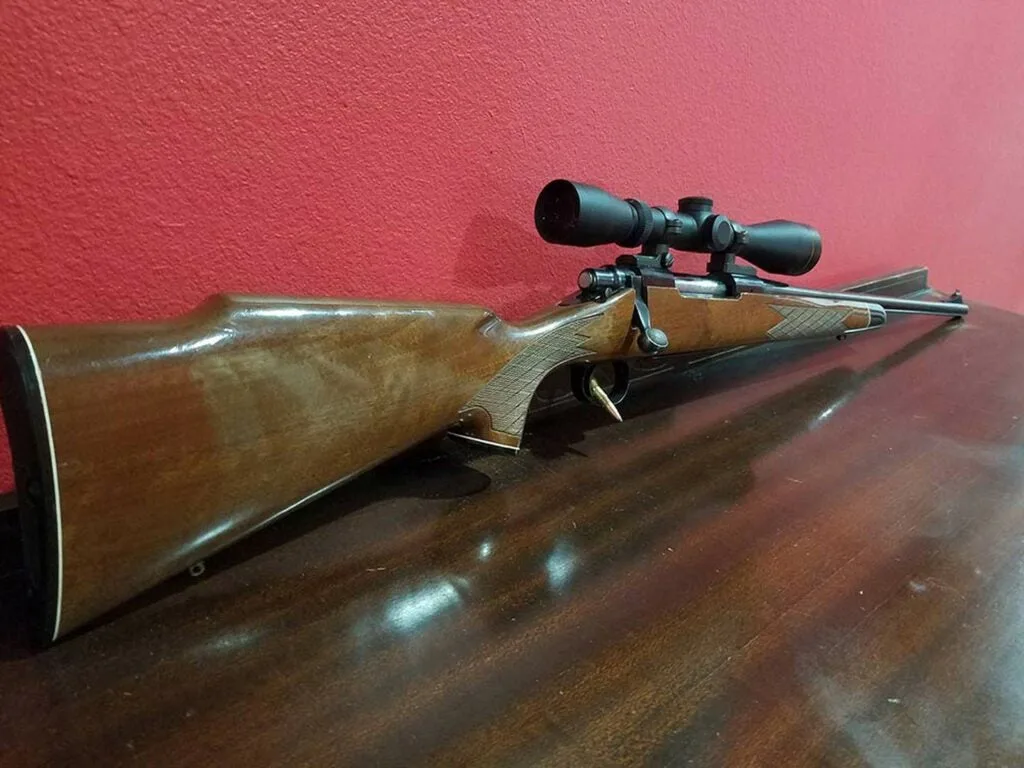
Alex’s Model 700, which he inherited from his father. Reader
I don’t know if you could really call this rifle old, but to me it is. It is a Remington 700 BDL in .270 Winchester that was bought brand new in the early or mid-1980s for $350. What astonishes me about this rifle is that it will shoot anything, from 100-grain varmint bullets to 150-grain elk loads, into the same hole. It’s also the only “hunting” rifle I have seen to shoot legitimate MOA groups at 300 yards. I wasn’t able to shoot those groups, but my dad was. This was his only rifle for about 35 years. He took this rifle on our first elk hunt together last year. It turned out to be our last hunt together. We lost dad in a tractor accident a couple of weeks after we returned home. So this coming fall I’ll have another tag in my pocket and dad’s old rifle with me, and I’m hoping to get the bull he didn’t get last year. —Alex
18. Savage Model 99
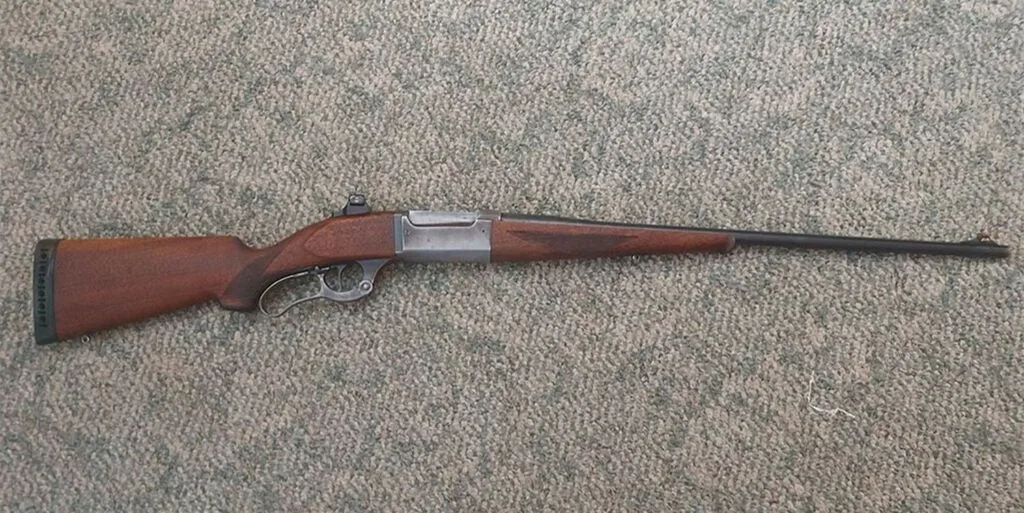
This old 99 will return to the Adirondacks for deer season this fall. Reader Photo
This is my grandfather’s Savage Model 99 in .300 Savage. It was his primary deer rifle for over four decades. The gun has taken several Adirondack bucks, including a huge eight-pointer that weighed 202 pounds.
Even after age kept him out of the woods himself, my grandfather always loved to talk deer hunting and he insisted that his rifle be used during deer season every fall. The old rifle still shoots very well and its peep sight is great in the big woods.
My Grandfather passed away last August at the age of 90. His .300 is a source of a lot of sentimental value within my family. Although he also owned a matching 99 in .250 Savage, but the .300 was his favorite. —Nigel
Read Next: The 6 Best Deer Hunting Rifles for the Big Woods
19. Remington Model 24

This family heirloom rifle is the gun the reader used for small game around the farm when he was a child. Reader Photo
My grandfather bought this rifle around 1925. I started carrying it in 1951 when I was 10 years old as a boy on the farm in Iowa. I became a crack shot over the five years I hunted with that rifle. Cottontails, jackrabbits, gophers, pigeons, starling, and squirrels were fair targets, although I only shot rabbit and squirrels during the hunting season.
I had to retire the rifle about the same time my father passed away; modern high velocity ammunition was too much for it. I de-tasseled corn that summer to earn enough money ($47) to buy a Winchester Model 63 to replace it.
I still have the Model 24 and I occasionally take it out and shoot it with standard velocity ammunition. It is as accurate as my old eyes allow it to be now. In 1960, I bought a Browning ATD [SA-22] as a replacement for the Remington. It is the current model of John Moses Browning’s genius as a gun designer. It is everything my Model 24 is, but it does not have the grace, Schnabel forearm, and petite size of the Remington. —Bob
20. 1898 Springfield Krag Jørgensen
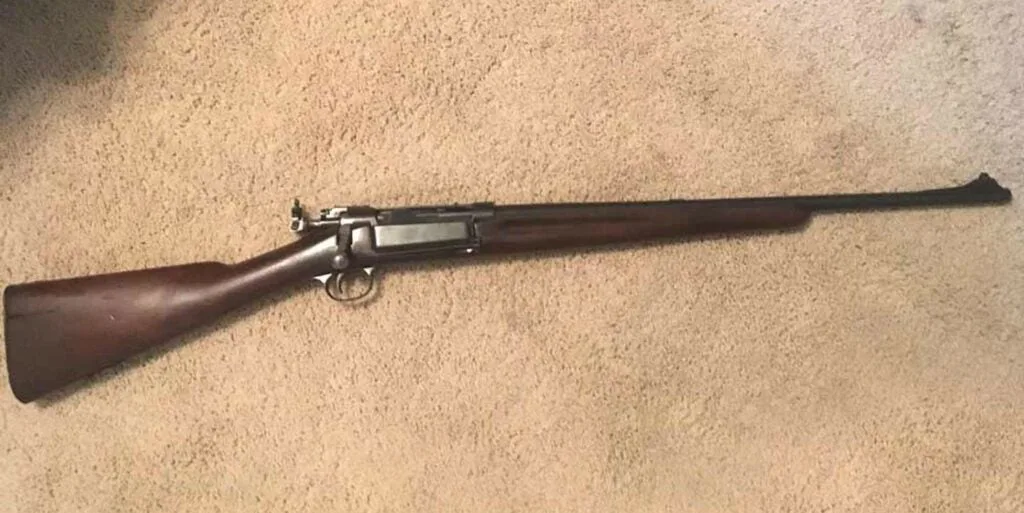
More than a century after it was manufactured, this rifle remains in mint condition. Reader Photo
This Springfield 1898 in .30/40 Krag belonged to my wife’s grandfather who nicely sporterized it. The barrel has been cut down and re-crowned with a Marble’s No. 3 ivory bead and a Lyman 1A peep sight dovetailed into the bolt plunger. This rifle was manufactured in 1901, and 111 years later I was fortunate to kill two does while stationed at Fort Benning, Georgia. The bolt is glass smooth and since it is in such nice, if not original, condition, I only hunt with it on perfectly dry days. —Jon
21. Remington Model Four

Fitting to the owner’s name, this rifle is a wild-hog killer. Hog Hunter
I purchased this .30/06 Model Four a few years ago at a pawn shop for $250. It currently wears a Nikon 3x9x40 scope with BDC reticle. The well-used Monte Carlo stock helps to get a good cheek-weld when sighting through the scope. The barrel appears to have been cut to carbine length after it left the factory and makes the overall package excellent for all-day carry in the thick woods where I find deer and pigs. It can hold about 2-inch, 100-yard groups with Remington CoreLokt factory loads and used this combination a couple of years ago to take my largest pig to date. I also bagged another pig and a small whitetail buck within the next two hours with that same rifle. —Hog Hunter
22. Winchester Model 94
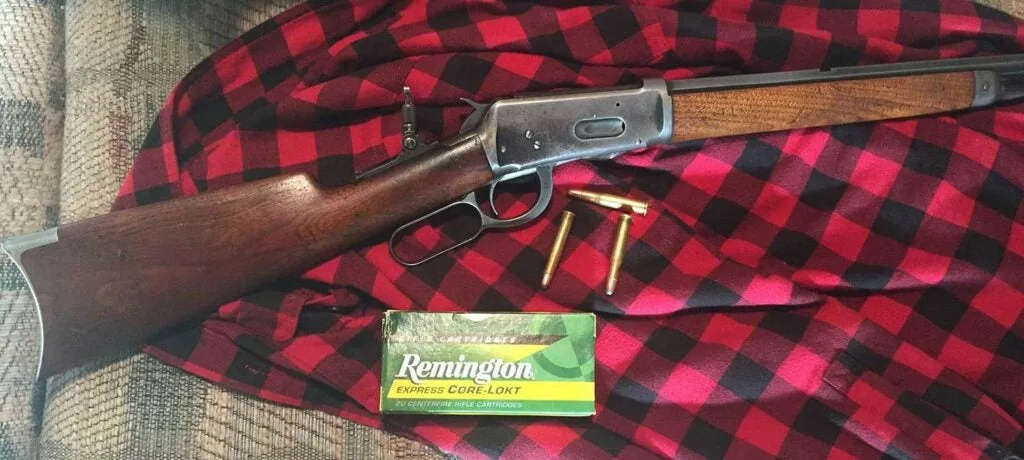
This Winchester Model 94 belonged to Harold’s grandfather, who purchased the rifle used when he was 19 years old. Reader Photo
This is a picture of my grandfather’s Model 1894 .30/30 Winchester. Actually, it belongs to me now but my grandfather bought it used when he was about 19 years old and was his only big-game rifle for his entire life. The old saying, “Beware of a man with one gun; he probably knows how to use it!” pretty well sums it up. He was famous in the little mining town in the northern Black Hills of South Dakota for shooting running deer through the neck. His friends called him Old Neck Shot. I’d love to know how many four-legged victims this rifle has accounted for, but I’m sure it’s well over a hundred.
The rifle itself was manufactured in 1897 when my grandfather was only a year old. He bought it off an old retired professor at Spearfish Normal School, who was done hunting and needed the money more than the gun. Actually, I should say guns, because Granddad bought both this one and its consecutively numbered twin from the old boy. Soon after, he sold one and kept one—dang it! As you can see, it has the curved steel butt plate and fore-end cap of the really old model 94s. The back sight is a Lyman tang peep with the front being a flip-up with both a post (topped with an ivory bead) and the other a ball-on-a-post within a circle target sight. I don’t think Granddad ever used the second front sight; it’s really hard to use. The long eye-relief aids accuracy and the weight-forward balance of the 26-inch octagonal barrel helps hold the rifle steady. Despite long years of use, it’s in excellent working condition. The bore is pretty darn good considering its age. Accuracy is only fair with regular .30/30 ammo but improves considerably with Hornaday’s LEVERevolution. Naturally, it shows the marks of time and many hunts. Most of the blue is gone from the receiver, and the rest is thinning. The stock shows its age but hasn’t been abused. I’ve killed one doe mule deer with it and I’m hoping to take it afield the next time I hunt the Black Hills.
So, while I’m the current caretaker of Granddad’s gun, it’s really his gun. When I pick it up, I can still see him walking down a snowy forest road in November, with his cap, red and black checkered coat, green wool pants, and this rifle clutched in his right hand while his grin telling us that another deer has fallen to him and his rifle. —Harold
23. Winchester Model 71
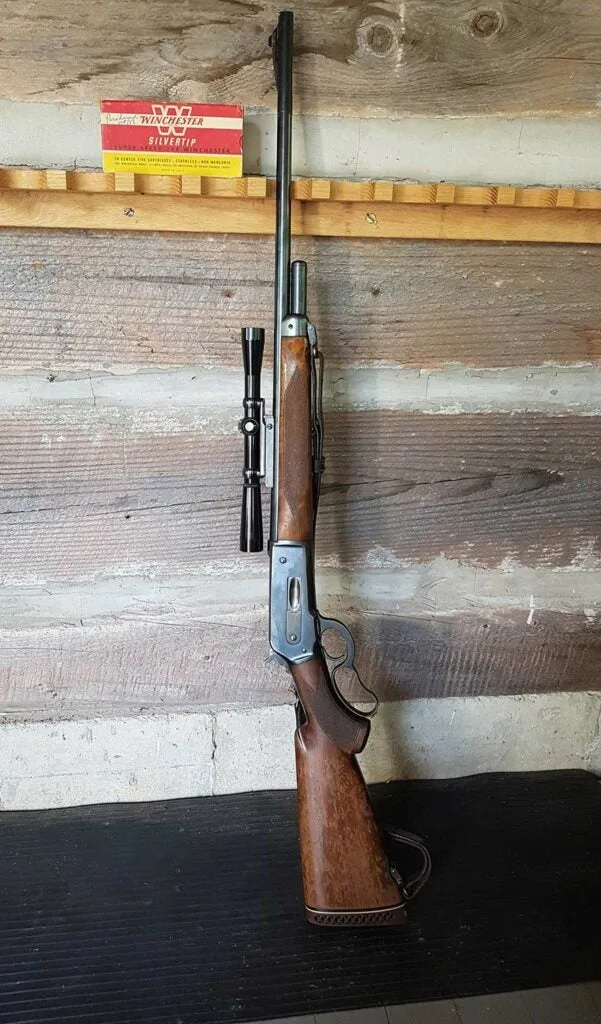
A vintage Winchester Model 71—as classic as ever. Reader Photo
This Winchester Model 71 is a gun my father bought new while working in New York City in the 1950s. Thereafter he used it as his big-game rifle, primarily for whitetails. Due to its sound and kick, he named it Roaring Mag, after the famous British mortar Roaring Meg (of the English Civil War). One year he got lucky and flattened a large black bear with it, and that bear rug adorned our house for years. As a boy, I was occasionally allowed to take the rifle out of the case and marvel at it, dreaming of the hunts to come.
This year, I finally took it afield again and fulfilled some of those boyhood dreams by shooting a nice bear. The rifle has seen hard use as the stock shows. Purists will scoff at the scope. Winchester fans will recognize the Redfield M294 as an elegant solution to the top eject lever guns for guys like my father—and now myself—who have aging eyes. Anyhow, it was nice to hear Mag roar again and claim another bear rug for our home. —Bernard
24. Husqvarna Model 640
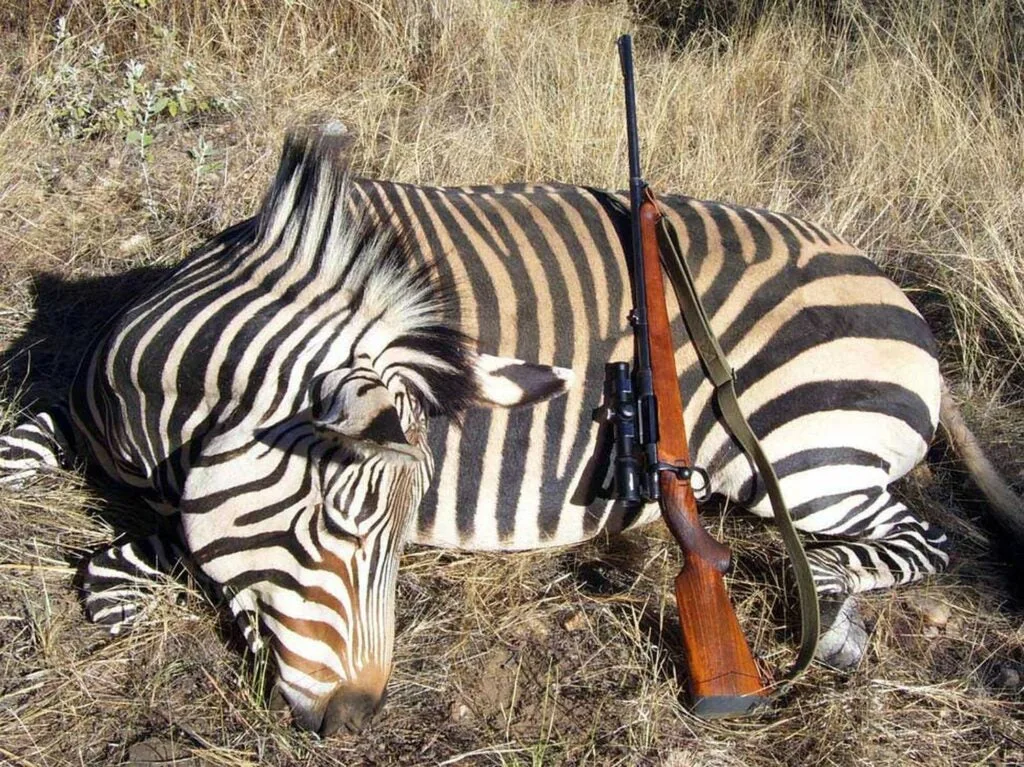
A Husqvarna Model 640 Sporter, chambered for the 8x57JS Mauser cartridge. Reader Photo
Here is my Husqvarna Model 640 sporter, chambered for the 8x57JS Mauser cartridge, one of the first—and greatest—smokeless powder rifle rounds ever developed. It is a purpose-built sporter made in 1944. It’s one of the very last true dedicated sporters on the Mauser 1896 action. Husqvarna discontinued sporter production in 1944, and when they resumed sporting-rifle production in 1948 they built them on purchased FN-made M98 action.
This rifle isn’t an ex-military weapon; though it does have a stripper clip slot in the receiver bridge, it lacks the “thumb cut” in the left receiver rail typical of military rifles. The barrel is not stepped, and the rear sight is a single fixed open leaf. The stock is a Schnabel-tipped piece of European beechwood with modest checkering but no other ornamentation beyond a plastic grip cap. It’s a plain-vanilla working rifle intended for the domestic market. (The European export market was pretty dismal in 1944!) My only changes were the additions of a recoil pad and a Burris Timberline 4×20 scope in a detachable mount.
While the M98 was far more popular and successful for sporting use, it’s a little too porky for a light hunting rifle. The M96, on the other hand, is sleek and graceful, trimmer and better balanced, and makes up into a wonderful lightweight sporter. Commercially made examples of sporting 1896s aren’t often seen, more’s the pity. The M96 is less popular with Americans because of its cock-on-closing bolt, but this design allows a simpler, lighter, and slimmer bolt design.
This little rifle has done me proud in the years I’ve owned it. I took it to Namibia in 2010, where I shot a huge Livingstone eland, a big zebra, a springbok, an impala, two warthogs, a baboon, and a few black-backed jackals. In the U.S. it has taken several whitetails and a feral hog. I now use it as a “culling” rifle for deer taken on kill permits.
That the 8x57JS Mauser round has faded away for sporting use in the U.S.A. is unfortunate, because it’s as effective and efficient a medium-bore hunting caliber as could be found. American ammunition companies deliberately under-load it to the level of the .30/40 Krag. Norma loads it to its full potential: 196 grain bullets with a muzzle velocity of 2526 FPS and 2776 F-P of energy. That is comparable to the .308 and .30/06. —New River Valley Outdoorsman
Strange and Truly Rare Guns
25. A. Dickore Cape Gun
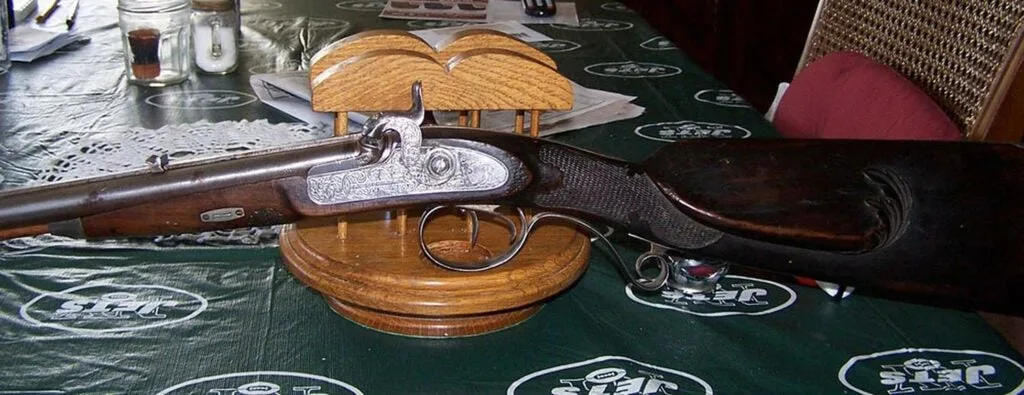
This Germanic cape gun is well over a century old. Reader Photo
As close as we can figure, this rare gun has been in our family for 150 years. It was taken West to Arizona in a covered wagon, and brought back when Indians burned down the homestead. In Geissen is inscribed on the left side and A. Dickore on the right. The hammers are fish with solid gold eyes. It is beautifully engraved all over with a cougar, deer, rabbit, and hunter. The right barrel is rifled and the left is smooth bore. —Gary
26. The Sharpshooter “Fly Gun”
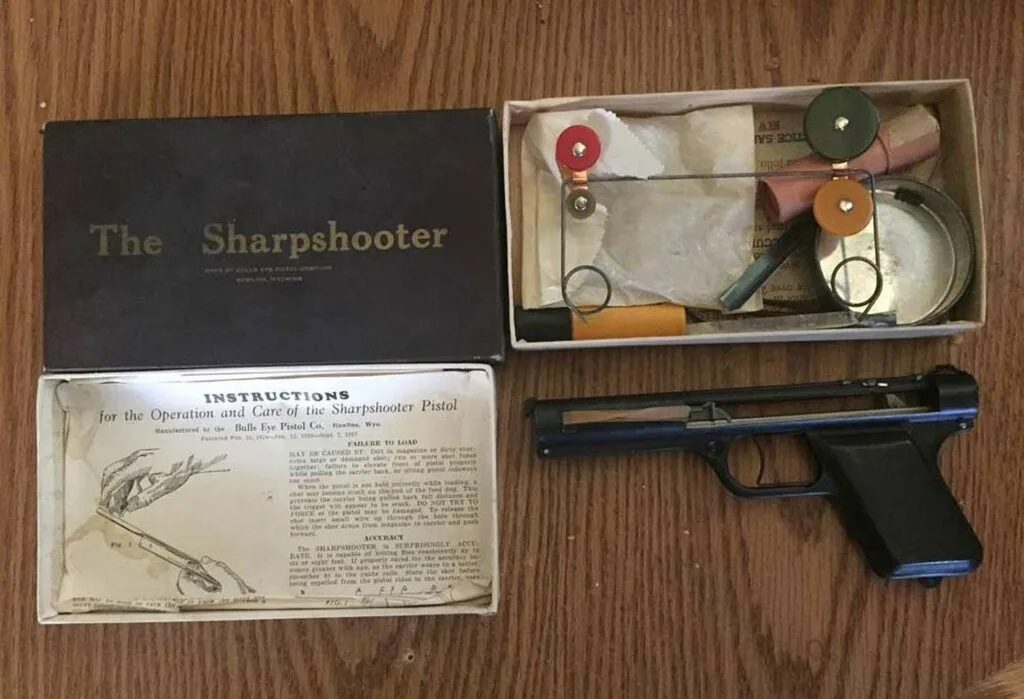
The Sharpshooter is the original fly-swatter gun. Reader Photo
This gun is undoubtedly a stretch for this website, but I hope you’ll bear with me. This is the Sharpshooter fly gun. Looking at the patent dates and the font style of the instructions, I would say this was manufactured sometime in the late 1930s in Rawlins, Wyoming. It was given to me by a friend who I met while we were both living in Rawlins. He found it at a flea market in Seattle. The whole kit comprises two boxes: The first contains the gun itself with a set of instructions. The second box has some bakelite spinning targets, rubber bands, tubes of No. 6 shot, and a device to load the shot into the gun. To fire this wicked weapon, you load some shot into the tubular magazine, affix the rubber band, and pull back the carrier until the sear catches. One No. 6 shot will drop into the carrier. When the trigger is pulled, the rubber band flings the carrier forward, launching the single shot out of the gun. According to the instructions, “The SHARPSHOOTER is SURPRISINGLY ACCURATE. It is capable of hitting flies consistently up to six or eight feet.” Now I haven’t been able to achieve such accuracy, but when I figured out where it was hitting I killed a few by getting a foot or two from them. Amazingly, the rear sight is adjustable for windage and elevation. So, if you have some time, and flies to kill, and don’t mind littering your abode with lead shot, this is your gun of choice. A good flyswatter is more efficient, but what the heck, this classic, rare gun is fun and harmless—even if you hit someone in the eye (supposedly). —Harold S.
27. Smith & Wesson Straight Line Target Pistol
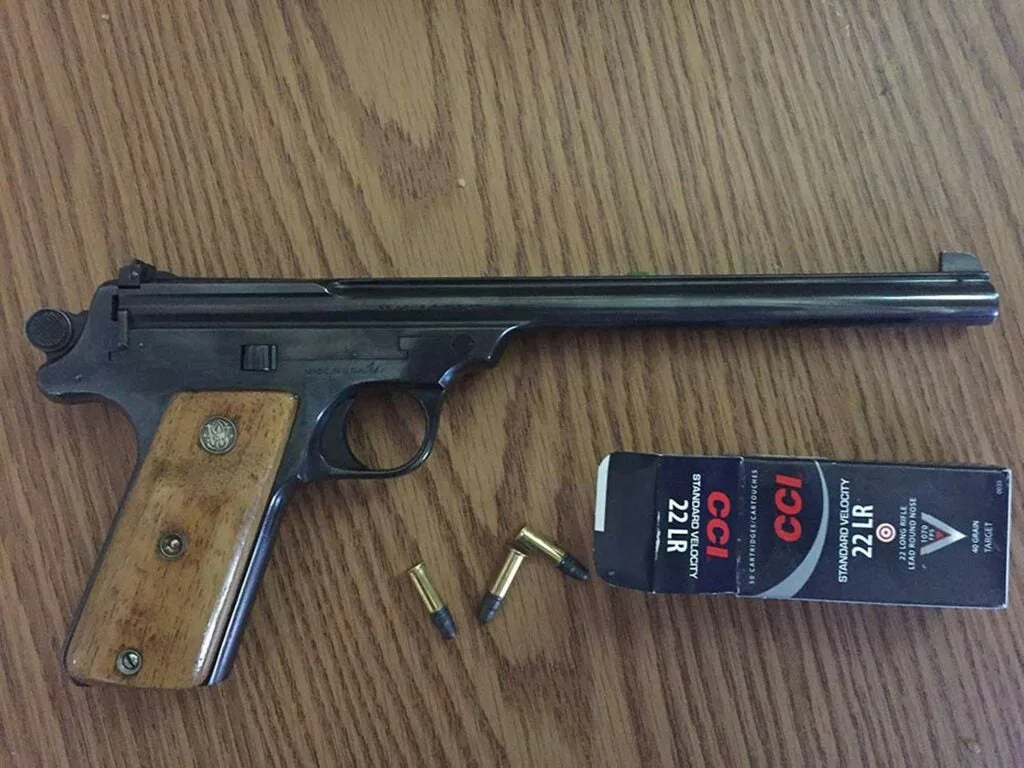
The Smith & Wesson Straight Line Target Pistol was discontinued in 1936. Reader Photo
What, at first glance looks like a trim semi-auto pistol is really my Smith & Wesson Straight Line target pistol. Instead of making a top-break based on revolver frames, like the first three models, Smith & Wesson decided to do something innovative. In place of a hammer revolving around a pivot, this pistol has an in-line hand cocked striker. The designers thought that an in-line striker would eliminate the downward push on the barrel that comes from a pivoting hammer. Sales were good at first, but it was soon discovered that the new design had little advantage over the old design, and in 1929 the Depression began. Sales dropped off and only 1,870 were made.
To load this puppy, first pull the striker back to “half-cock,” then grab the stock with your right hand and the barrel with your left. Push the button on the left side to the right with your left thumb, then pivot the barrel counterclockwise. A spent case will then be extracted but not ejected. After plucking out the empty out, you reload and pivot the barrel back into battery. After pointing the pistol in a safe direction, pull the striker all the way back and you’re ready to fire. How does it shoot? Pretty good, but it’s a little light for a target pistol. Although this pistol was certainly not a financial success, the machine work and finish are out of this world, and it’s probably a pretty rare gun nowadays. Fortunately, this one came as-is. If it had the metal case, paperwork, and tools, it would have cost an extra $1,000. —Harold S.
28. Stevens Favorite
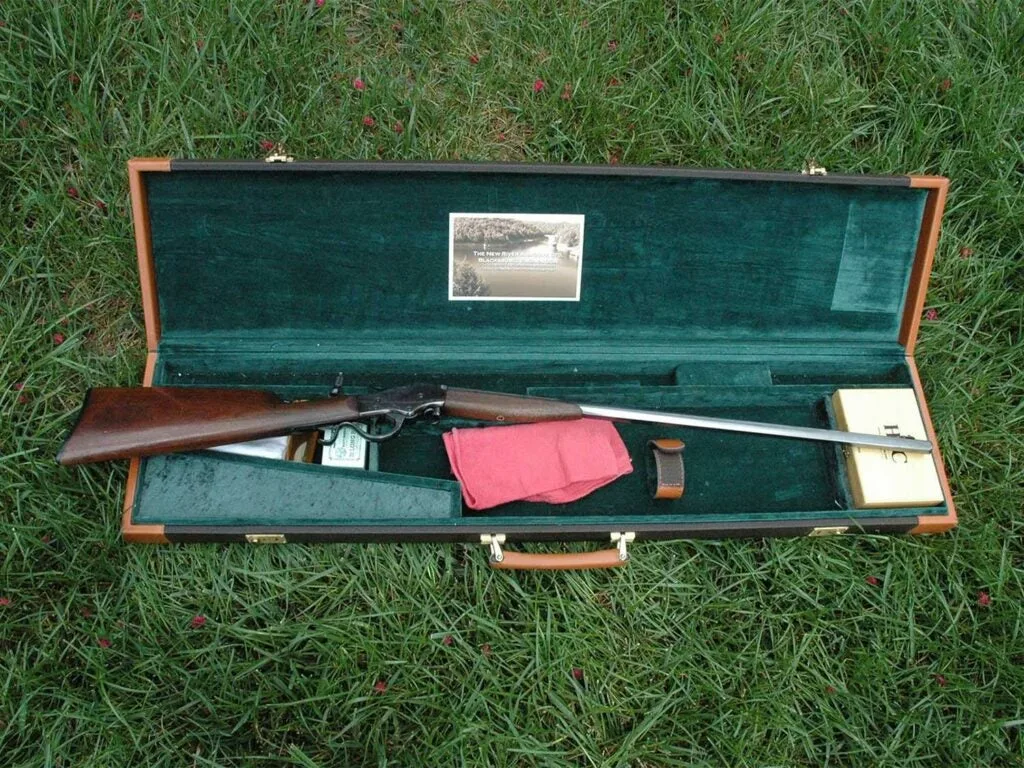
This Stevens Favorite is a single-shot rifle chambered in .32 Rimfire, a cartridge that is no longer produced. Reader Photo
Here is my Stevens Favorite Model 1894 “rook rifle.” It was in decent, shootable shape when I bought it, but I wanted something special. I had it refinished, added an original Stevens folding tang sight to match the factory’s “Beach’s Patent” folding front sight, and fitted up a case for it.
This rare gun is chambered for the now discontinued .32 Rimfire. It’s a great pity that this cartridge is no longer manufactured because it’s an outstanding small game round, and there are many high-grade rifles like mine languishing for want of ammunition. Some people have converted these little rifles to shoot .32 S&W Long; a very foolish thing to do, because the Favorite is a weak action and hot handloads will stress it beyond its limits. However, a company in France makes reloadable .32 Rimfire cases. I bought one of their kits and was also able to track down a few boxes of factory ammunition, loaded by CBC in the 1970s. Although Stevens made and sold the Favorite mostly in the U.S., they also did export trade in the U.K. through one Joseph Leeson, a well-known gunsmith and dealer. Leeson imported the Favorite in classic rook rifle calibers. —Tom
29. Stevens 40 ½ Pocket Rifle
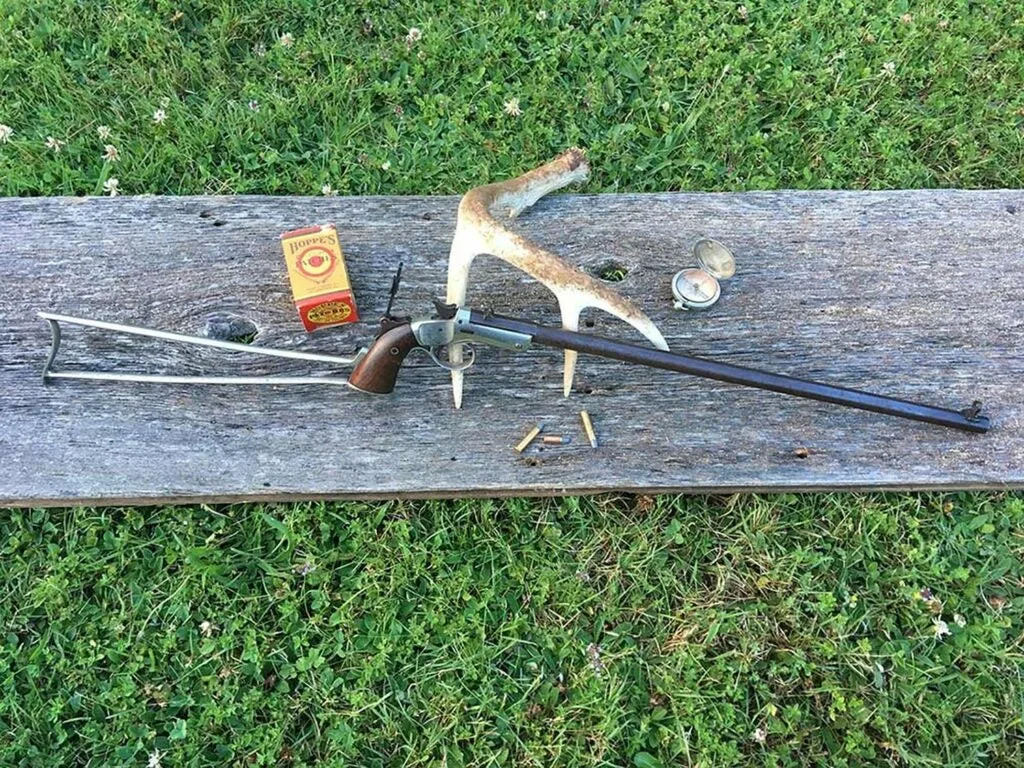
While it was compact, the Stevens Pocket Rifle won’t fit inside any normal pocket. Fitch 270
This is my Stevens 40 1/2 Vernier New Model Pocket Rifle in .25 rimfire. My grandfather gave it to me a couple weeks after my 13th birthday with conditions: He told me his grandfather had given it to him, and I was to give it to a grandson someday. Once I turned 30, or if something were to happen to my dad and we needed the money, then I could sell it. Grandpa passed of an unexpected heart attack a couple weeks later, the day before the deer opener.
It turns out he fibbed. My dad’s older brother was a kid when he found the rifle in the rafters of an old milk house on the property they’d bought. The gun was probably used for pest control in the barn.
I don’t know for sure what my grandfather’s reasoning was, but apparently he had told folks for years he wanted me to have this rifle. He had no will when he died and it took years to settle his estate. He had eight kids and over 30 grandkids. There’s no way I’d have ended up with such a rare gun if he hadn’t given it to me when he did.
I shot it a few times just after he died, but ammo is hard to find, pricey, and not reloadable. I have a few boxes left, waiting for the next owner in line. —Fitch 270
Why Trust Us
Field & Stream is dedicated to covering safe and responsible gun ownership for hunting, recreation, and personal protection. We participate in affiliate advertising programs only with trusted online retailers in the firearms space. If you purchase a firearm using the links in this story, we may earn commission

